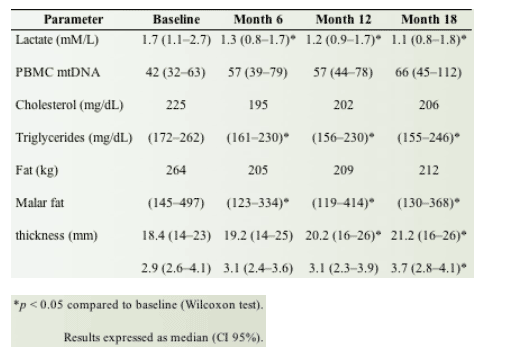 |
 |
 |
| |
Switch to Tenofovir Improved Lipids, Fat Loss
|
| |
| |
"Improvement of Subcutaneous Fat, Lipid Profile, and Parameters of Mitochondrial Toxicity in Patients with Peripheral Lipoatrophy when Stavudine Is Switched to Tenofovir. The LIPOTEST Study"
Spanish researchers switched patients with lipoatrophy from d4T to tenofovir, and reported study results in poster 860 at the 12th CROI. This study is another in a line of several recently reported studies showing that switching nukes from a thymidine to a non-thymidine nuke can improve fat loss. That is, switching to abacavir or tenofovir has been shown in studies to improve fat loss (lipoatrophy). Longer term studies are needed to better characterize & confirm these findings.
Stavudine (d4T)-associated mitochondrial toxicity may play a role in the etiology of lipoatrophy. We hypothesised that switching from d4T to tenofovir (TDF) will result in an increase in mtDNA in peripheral blood mononuclear cells (PBMC) and an improvement in lipid profile and peripheral lipoatrophy.
We enrolled 53 subjects with HIV-1 RNA < 50 copies/mL on d4T-based ART regimens with lipoatrophy. While the other drugs were maintained, d4T was switched to TDV, and patients were prospectively followed. Fasting plasma samples were obtained for measuring lipid profile and lactatemia. A real-time PCR assay was used to quantify mtDNA/nDNA ratio in PBMC. Fat mass and subcutaneous malar fat thickness were determined by bioelectrical impedance analysis and sonography, respectively.
Baseline characteristics were: mean age of 40 years, 68% male, median CD4 count 434 cells/ÁL. After 18 months of TDV therapy in no case was TDV withdrawn for adverse effects or virologic failure. Two patients with virologic failure had virus isolates remaining sensitive to TDV. No significant differences occurred in CD4 cell count. Median values of lactate levels, mtDNA ratio, lipidic profile, and fat mass and malar fat (Bichat) [facial fat] thickness are shown in the table.
As you can see in the table, 18 months after the switch, lactate improved from 1.7 to 1.1 mM/L (significant), PBMC mtDNA improved nonsignificantly from 42 to 66, cholesterol improved non-significantly from 225 to 206 mg/dL, triglycerides improved significantly (from 172-262 to 155-246), fat (kg) improved non-significantly from 264 to 212, malar fat (facial) improved significantly from (145-497) to (130-368)--the thickness improved significantly from 2.9 to 3.7 mm.
|
|
 |
| Switching from d4T to TDF was well-tolerated and virologic and immunologic success was maintained. Patients showed a rapid improvement of the lipid profile, decrease in lactate levels and a slight amelioration of mtDNA content in PBMC. In addition, they presented a slow but significant recovery of the fat mass and the malar fat thickness (facial fat). |
| |
| |
|
 |
 |
|
|